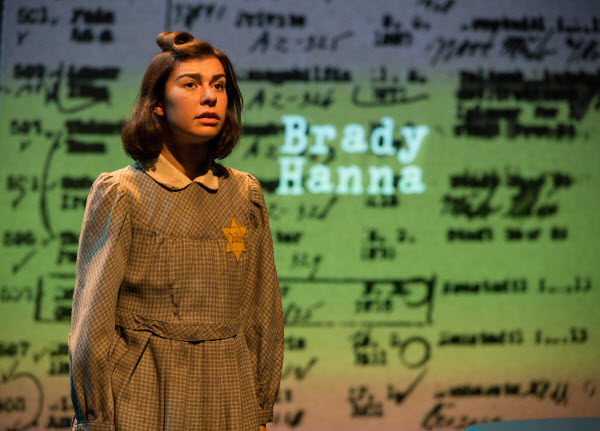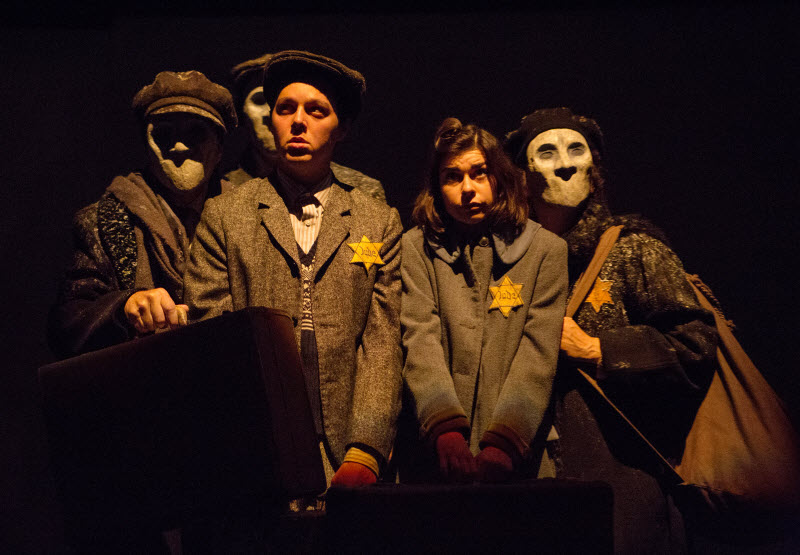
Bottom line
Hana’s Suitcase, running at Seattle Children's Theatre through Feb. 7, tells a heavy story with a light touch, never shying away from hard facts but leaving viewers with a sense of hope and purpose.
Highlights
Done right, theater has the power to educate, entertain and even catalyze action in the real world. ‘Issue stories’ can be a hard sell for families looking to enjoy a night out, but Hana’s Suitcase, the true account of a little girl killed during the Holocaust and the Japanese woman who brought her story to light, is theater done right. (Read more about the history of Hana's Suitcase.)
The first act follows Fumiko Ishioka, the director of a small Holocaust education center in Japan, and two of her students as they seek information about the little girl who owned a suitcase on exhibition at the Center. Acknowledging that the story of Hana Brady is unlikely to end happily, the characters make a pact with each other, and in essence, with the audience early in the play.
“If Hana’s story is a sad one, if it makes us feel sadder than sad, we must find a way out of the sadness. Agreed?”
Hana Brady was killed at Auschwitz, but Ishioka discovers that Hana’s brother George survived and lives in Canada. She writes to him, asking for information about Hana, and his answers make up the second act of the play.

In both acts, characters from the past and present share the stage, living and learning the story simultaneously. I was worried that this sophisticated presentation might confuse children, but my 11-year-old had no trouble keeping the parallel tracks of the story straight. If the questions children asked during the post-show Q&A were any indication, this format was very effective. One boy brought many adults to tears with his question about life before the war that showed how hard he was trying to understand the lived experience of discrimination.
In the play, one child says, “Stories don’t die,” and Fumiko answers, “Stories do die if there is no one to tell them.” But Hana’s Suitcase goes beyond telling one story out of the 1.5 million children whose stories may have died with them. Hana’s Suitcase gives viewers something to do with the knowledge. Throughout the play, we are reminded that the reason we need to know what happened is to know how to keep it from happening again.
On opening night, George Brady and Fumiko Ishioka participated in the Q&A after the performance. Ishioka explained that it’s too easy to focus on the facts of the genocide when violence was the end result of a process that took over a decade. Hana’s story draws attention to the progression from small acts of stereotyping to unthinkable violence. It shows how important it is to act in response to the discrimination that we see around us now.
Parents should know
Hana’s Suitcase doesn’t pull any punches. We learn about the discrimination Hana’s family faced before the war, the children’s separation from their parents, the hardships of life in the Theresienstadt ghetto and the fact that George is the only Brady who was not gassed in Auschwitz.
But there is no onstage violence or gruesome images. Few of the hardest facts are directly witnessed; usually they are presented to the audience through the separation of time they are discovered by the modern-day characters. The youngest character, Akira, provides relief with childish antics and misunderstandings. But the play is still an intense experience recommended for ages 10 and older.
Parent tips
• Booster seats are available at no charge just inside the auditorium doors.
• Light concessions are available before the curtain rises. Cash only. Seattle Children’s Theatre is only steps from the Seattle Center Armory for those looking to eat before or after the show. No food is allowed inside the auditorium.
• Hana’s Suitcase is a 90-minute production in two acts with one short intermission.
• If you do attend with younger children or children who cannot remain quiet during the performance, a quiet room with a window to the stage is available.
• Bring tissue. There will be tears.
• Consider reading Hana’s Suitcase on Stage before you attend. It includes both the children’s book by Karen Levine and the play by Emil Sher. It is one of the Seattle Public Library’s current Global Reading Challenge Books for fourth and fifth graders, which means many copies of the book are available at most branch libraries. An age-appropriate reading list prepared by the Holocaust Center for Humanity is presented in the booklet for those who want to pursue the subject further after seeing the play.
If you go ...
Where and when: Seattle Children’s Theatre is located at the Seattle Center, between the Pacific Science Center and the Armory. Hana’s Suitcase will be performed Thursday through Saturday evenings and Saturday and Sunday afternoons through February 7.
Tickets: Tickets can be purchased online. Prices vary by performance, ranging from $22–$40.
Parking: Parking near Seattle Center can be challenging and expensive. Visit the SCT Parking guide for more information.











